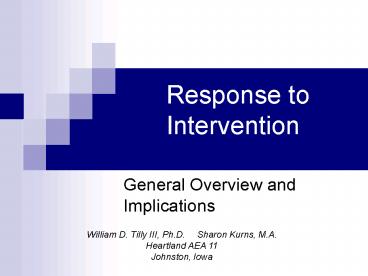Response to Intervention - PowerPoint PPT Presentation
1 / 15
Title:
Response to Intervention
Description:
... (2) using learning rate over time and level of performance to (3) make important ... Use research-based, scientifically validated interventions/instruction ... – PowerPoint PPT presentation
Number of Views:40
Avg rating:3.0/5.0
Title: Response to Intervention
1
Response to Intervention
- General Overview and Implications
William D. Tilly III, Ph.D. Sharon Kurns,
M.A. Heartland AEA 11 Johnston, Iowa
2
Objectives
- Overview of RtI
- Define RtI
- Where did it come from and why we need it
- Core principles
- Critical components of RtI
3
Definition
- RtI is the practice of (1) providing high-quality
instruction/intervention matched to student needs
and (2) using learning rate over time and level
of performance to (3) make important educational
decisions.
4
RTI Models - Where Did They Come From?
- History of teaching to the middle
- Some succeeded, some didnt
- Most solutions moved problems, didnt solve them
- NCLB requires many, many additional students to
become proficient in Reading and Mathematics
5
RTI Models - Where Did They Come From?
- Bergan Consultation Model
- Denos Problem Solving Model
- Vaughns Three Tier Model
6
Common Elements
- Systemic process and framework
- Implementation of scientifically based
interventions - Frequent data collection
- Instructional decision making based on student
performance
7
RtI Core Principles and Practices
- Believe that we can effectively teach all
children - Intervene early
- Use a multi-tier model of service delivery
- Use a problem-solving method
- Use research-based, scientifically validated
interventions/instruction - Monitor student progress to inform instruction
- Use data to make decisions
- Use assessments for three different purposes
- Address the needs of struggling and advanced
learners
8
Essential Components of RtI Implementation
- Multi-tier model
- Problem solving method
- An integrated data collection/assessment system
9
Essential Component 1 Multi-tier Model
1-5
1-5
5-10
5-10
80-90
80-90
10
Essential Component 2 Problem-Solving Method
11
Essential Component 3 Integrated Assessment
Systems
- Directly assess specific skills, knowledge, and
understanding - Assess marker variables
- Sensitive to small amounts of growth
- Brief
- Repeatable
- Easy to use
- Direct relationship to instructional decision
making
12
RtI and Mathematics
- Early implementation tends to focus more on
reading - Core principles apply
- Challenges in mathematics exist
- Lack of formative assessments
- Feasibility of conducting diagnostic assessments
on large groups of students - Challenges in creating flexible structures to
provide instruction - Professional learning about effective
instructional practices
13
NCTM firmly believes that all children can
learn. At the same time, the Council understands
that not all students learn at the same rate or
in the same way. In the gradual journey toward
mathematical understanding, students may
experience difficulties that require
intervention. Moreover, some talented students
may need opportunities to be accelerated beyond
the curriculum that other students follow.
14
Fundamentally
- Doing this will take patience
- Doing this will take perseverance
- In doing this, well make mistakes. And fix
them. - Doing this will take courage.
- Doing this will take trust.
- Most importantly, doing this will require
leadership
15
- A leader is a person you would follow to a place
you would not go yourself.
Joel Barker, Future Edge, 1992































